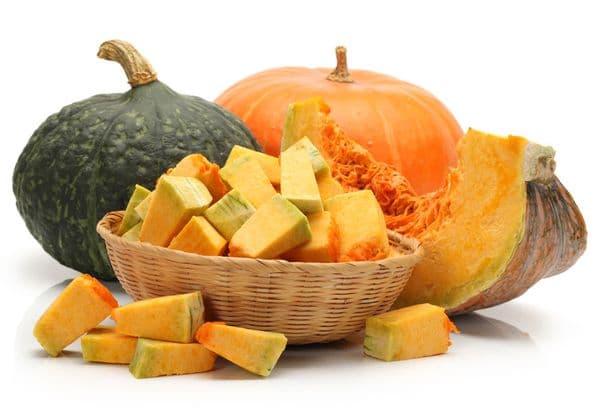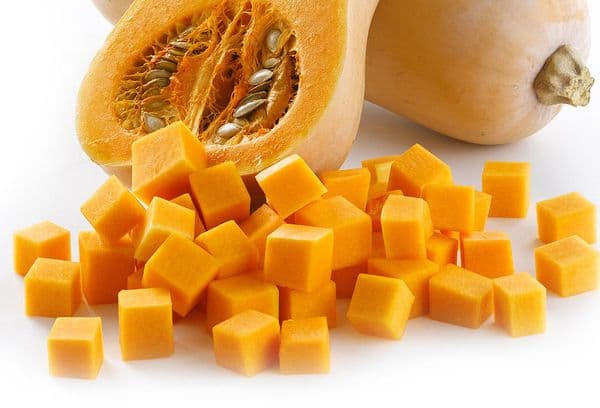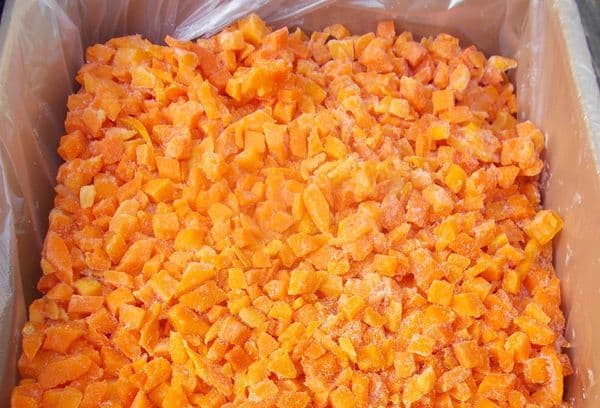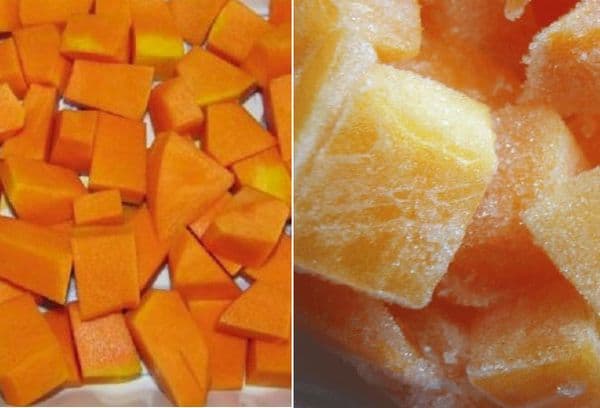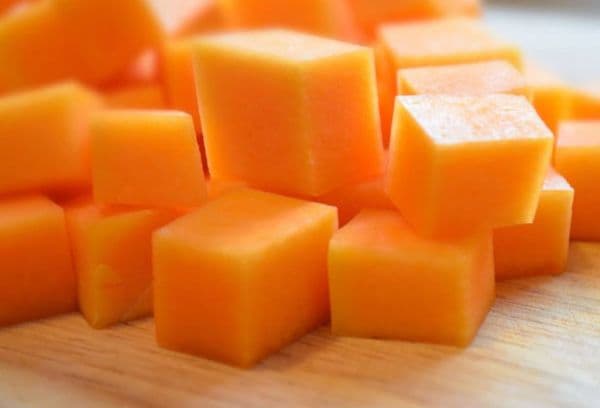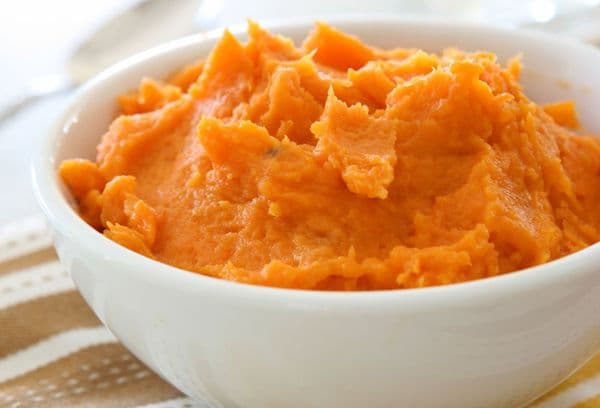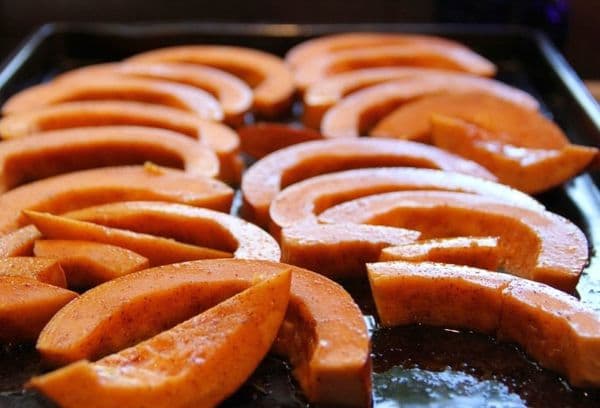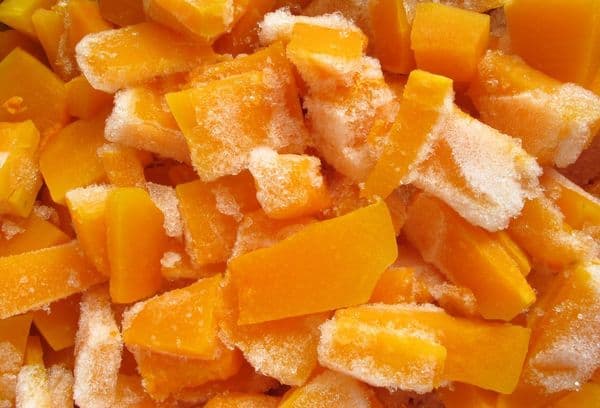Is it possible to freeze pumpkin raw, boiled, or baked? Subtleties of storage
Content:
You can freeze pumpkin for the winter in the freezer; this is one of the most popular storage methods after canning and cellaring. Those varieties of pumpkin that do not last long in their own peel are frozen in a variety of ways.
Is it possible to freeze pumpkin?
Pumpkin is a universal, very healthy and dietary vegetable, so many housewives try to preserve it not only until late autumn, but also for winter and spring - right up to the new harvest of orange fatties.
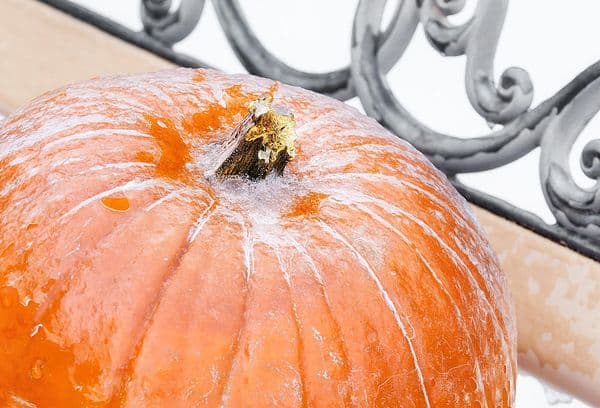
Pumpkin pulp tolerates canning and freezing well. Some varieties are stored well in the cellar until spring without additional effort on the part of the grower.
After storage at low temperatures, the pulp sometimes loses aroma, color and taste, as well as beneficial properties. Our tips will help you avoid mistakes in freezing and defrosting.
What types of pumpkin should be frozen?
There are three main groups of pumpkin varieties that are eaten:
- Nutmeg is the sweetest, but with a thin peel, which allows you to store the fruits in the room until winter at most.They are distinguished by unusual colors and bottle shape.
- Hard-barked - the name speaks for itself; these vegetables are stored for a long time thanks to their dense peel.
- Large-fruited - the leading varieties in terms of weight, are also well stored in the cellar.
Any type of pumpkin can be frozen, but for muscat types, freezing is the best way to store for long periods of time.
Freezing fresh pumpkin
The unusual thing about pumpkin is that after properly freezing the fresh pulp, it is very convenient to cook, sometimes even easier than fresh.
Many housewives are frightened by the size of the fruits - they are unlikely to fit entirely in the freezer. But this is not necessary: the pumpkin is stored in cubes, grated, cut into shapes, pureed, etc.
A few points in choosing fruits for long-term cold storage:
- Choose only high-quality, whole fruits without damage or rot.
- If the fruit has already been cut and stored in the refrigerator for some time, the result of freezing may disappoint you.
- It is recommended to wash and cut the fruits immediately before putting them in the freezer.
Preparing the pumpkin won't take long. Wash the peel thoroughly with a brush and soap - when slicing, dirt and bacteria will get into the pulp. Dry the fruit, cut in half in a convenient way. To do this you will need a board and a large knife. Now you need to scrape out all the pulp, and then clean it of fibers and seeds - all the same steps as when preparing pumpkin for puree, baking or boiling.
How to freeze correctly:
- Only the hard part of the fruit is stored in the freezer. Cut the vegetable into cubes (any size, you can use a curly knife to use wedges for salads and soups).
- First, the bars need to be frozen individually so that they do not stick together due to slight swelling during long-term storage. Place them on a baking sheet or flat dish, cover with cling film and place in the freezer for 2-3 hours.
- When the pulp freezes, transfer it to bags or containers. Be sure to seal the pumpkin airtight, leaving very little air in the container.
- Place the pieces in convenient portions so that you don’t have to take out the right amount each time. It is better to avoid temperature changes - put the pumpkin in the freezer once, remove it once. Moreover, you should not re-freeze an already thawed product - it will lose everything for which it is valued by nutritionists and cooks.
- You can extend the shelf life using a vacuum bag and sealer. Use food-grade equipment.
Advice
Do not throw away pumpkin seeds, but rather fry them and save them: this product contains rare trace elements.
A not very popular, but extremely convenient way to freeze pumpkin is to grate the pulp. It is packaged in small bags and used in preparing vegetable cutlets and pancakes, and for filling pies. There is no need to pre-freeze the mixture.
How to use raw pumpkin after defrosting. Defrosting rules
The optimal method is further heat treatment of the vegetable:
- Add the cubes to soups and pureed soups.
- Stew cubes as a side dish for meat and fish.
- Boil the pulp for warm salads.
- Add defrosting while cooking porridge, oatmeal, semolina, etc.
- Use pumpkin slices for desserts. It could be a pumpkin and apple pie, simply baked pumpkin in sugar or honey, cottage cheese casserole and other homemade sweets.
Advice
For desserts and casseroles, cut the vegetable into cubes, for pancakes - grate or cut into small strips, for soups and cereals - into larger cubes with an edge of 2-3 cm. Keep different types of cuts for all kinds of dishes in the freezer.
Defrosting
Proper thawing is just as important as freezing: if you leave the pumpkin to thaw slowly, it will spoil and become unpleasantly watery. Immediately after removing the vegetable from the freezer, place it in a frying pan, oven, or saucepan with boiling water/broth. Often pumpkin pieces are added to a multi-ingredient dish. The orange vegetable is introduced last.
How to Freeze Cooked Pumpkin
Frozen in the form of boiled or baked puree stores just as well as raw pumpkin. Let's look at all the pre-cooking methods. Preparing the fruits is similar to the method with raw pumpkin: washed, chopped, removed excess parts.
Boiled pumpkin, puree
It is not recommended to boil pumpkin pulp for longer than 10-15 minutes, otherwise it will lose a lot of vitamins. Fresh pumpkin boils easily, especially if you cut it into small cubes.
A boiled vegetable turns best into puree; it is in this form that housewives store the pulp in the freezer in winter. How to pack puree, ideas:
- Place the mixture in plastic cups or buckets and cover them with cling film.
- Place in small plastic containers with lids.
- Use yogurt or sour cream cartons.
- Ziploc bags work too.
Tip from purity-en.htgetrid.com magazine: Use ice cube trays to make portioned pumpkin porridge for baby feeding.
Baked
For this method, do not peel the peel, but cut into cubes with a ready-made base.This way the pulp in the oven will not stick to the baking sheet due to the juice released. Baked pumpkin is very easy to remove from the crusts, this will separate even more pulp than raw.
It is not necessary to bake the vegetable for a long time - as soon as the pulp is easily pierced with a fork, it can be removed from the oven.
The finished blocks are cooled, frozen and placed in containers.
An equally healthy puree is prepared from baked pumpkin: simply mash the pulp with a fork or blender and pack in the same way as suggested in the previous method with boiled puree.
Blanched
The most gentle method of heat treatment is blanching. To do this you will need a pan of water and a colander:
- Place the chopped pieces in a colander.
- When the water boils, place the colander with the pumpkin in the pan and hold for no more than 2-3 minutes.
- Then pour cold (ice) water over the pulp.
- Dry the vegetables on a towel, freeze them individually and transfer them to storage bags.
Here is a simple way to keep pumpkin as healthy and edible as possible immediately after defrosting.
Defrosting cooked pumpkin
Long-term heat treatment of the finished pumpkin is no longer necessary, so defrost it in the microwave and immediately add it to dishes: hot cereals, soups, dough fillings, etc.
Shelf life of different pumpkins in the freezer
The standard shelf life of frozen vegetables is 10-12 months. It is best to use pumpkin under a vacuum, as well as one that has been thermally treated in advance.
Don’t wait until the deadline; eat pumpkin in the first months: this way the vegetable will be the most delicious and healthy.
And one last useful tip: if the freezer allows, store pumpkin preparations separately from other products.For meat, fish and seafood, use a separate container. The pumpkin can absorb their strong scent. Otherwise, there is no more convenient and practical freezing than from a red vegetable.
